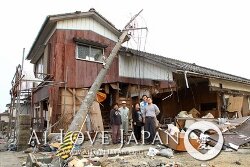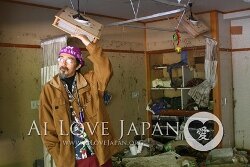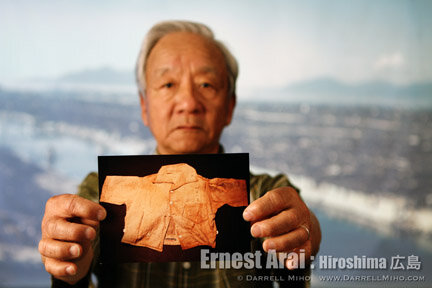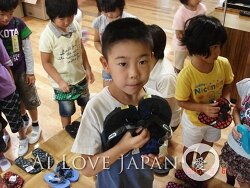Darrell Miho is a professional photographer and writer from Southern California. Darrell and fellow photographer, Ken Matsui, founded Ai Love Japan, an organization that documents survivor stories and provides direct aid to the people most affected by the earthquake, tsunami and nuclear crisis in Japan. He will be at JAMsj on February 3, 2013 and will talk about his organization and the current situation within the disaster zone. In this article, he recounts how he got involved in relief efforts.
By Darrell Miho
When the March 11 disasters struck Japan, I was literally on the other side of the world in Sao Paulo, Brazil. I couldn’t believe the video footage I was watching on TV. I knew this was bad and my immediate instinct was to go take pictures.
Unfortunately, I was stuck in Sao Paulo recuperating from emergency retina reattachment surgery and was unable to travel until my eye was healed. Stuck in a foreign country without many resources, I felt helpless not being able to do anything.On April 1, I was finally able to travel home to Los Angeles where I jumped on board to help some of my friends organize a benefit concert featuring Hiroshima and Quest Crew.Still feeling that I could do more, I planned a trip to Japan in May to work on a personal project documenting atomic bomb survivors. Once I was finished doing the interviews in Hiroshima and Nagasaki, the plan was to head north to the Tohoku region to document the damage and see how we could help. After visiting the devastated areas and talking to the local people, it was clear that more help was needed. Clearly, this disaster was unprecedented and the government was overwhelmed and unable to meet all the needs that people had.Since the March 11 disasters, I have now been to Japan 5 times and to the Tohoku area 8 times and I can say without a doubt, there is still a lot of work that needs to be done. Optimistic projections estimate that it will take ten years to rebuild the devastated areas. I think it will take longer. The added reality is that some places may never be rebuilt.
After visiting the devastated areas and talking to the local people, it was clear that more help was needed. Clearly, this disaster was unprecedented and the government was overwhelmed and unable to meet all the needs that people had.Since the March 11 disasters, I have now been to Japan 5 times and to the Tohoku area 8 times and I can say without a doubt, there is still a lot of work that needs to be done. Optimistic projections estimate that it will take ten years to rebuild the devastated areas. I think it will take longer. The added reality is that some places may never be rebuilt. Seeing the devastated areas in person will change anyone’s preconception of the disaster. Being in the midst of all the destruction and then seeing it repeated in town after town is something that I can’t put into words. The enormity and the scale is just mind-boggling. So I want to encourage people to go visit or volunteer so they can see it first hand and contribute to the recovery.When we asked one of the survivors what she wanted, she simply said to come visit. The last thing the evacuees want is to be forgotten. So I will do everything I can to make sure that doesn’t happen.-------------------------------------------------------------------------------------------------------- A native of Southern California, Darrell Miho is a professional photographer and writer specializing in people, sports, travel and special events. His work has been published in such notable publications as Sports Illustrated, Golf Digest and The New York Times. Miho extends his love for taking pictures to the community by donating his services to worthy causes. It is this inner desire to help others that motivates him to pursue personal projects that will help make this world a better place. He is currently working on two personal projects documenting atomic bomb survivor stories and earthquake and tsunami survivor stories:
Seeing the devastated areas in person will change anyone’s preconception of the disaster. Being in the midst of all the destruction and then seeing it repeated in town after town is something that I can’t put into words. The enormity and the scale is just mind-boggling. So I want to encourage people to go visit or volunteer so they can see it first hand and contribute to the recovery.When we asked one of the survivors what she wanted, she simply said to come visit. The last thing the evacuees want is to be forgotten. So I will do everything I can to make sure that doesn’t happen.-------------------------------------------------------------------------------------------------------- A native of Southern California, Darrell Miho is a professional photographer and writer specializing in people, sports, travel and special events. His work has been published in such notable publications as Sports Illustrated, Golf Digest and The New York Times. Miho extends his love for taking pictures to the community by donating his services to worthy causes. It is this inner desire to help others that motivates him to pursue personal projects that will help make this world a better place. He is currently working on two personal projects documenting atomic bomb survivor stories and earthquake and tsunami survivor stories: Project Hibakusha : Hope for Peace will create a traveling exhibit of portraits and multimedia presentations to promote world peace by educating future generations about the devastating effects that nuclear weapons have on people’s lives and to spread the hibakusha’s message – their hope for peace. Interviews and photographs are being conducted in Japan, South Korea, Brazil, Canada and the United States. http://projecthibakusha.blogspot.com
Project Hibakusha : Hope for Peace will create a traveling exhibit of portraits and multimedia presentations to promote world peace by educating future generations about the devastating effects that nuclear weapons have on people’s lives and to spread the hibakusha’s message – their hope for peace. Interviews and photographs are being conducted in Japan, South Korea, Brazil, Canada and the United States. http://projecthibakusha.blogspot.com  Ai Love Japan: The earthquake and tsunami survivor stories are being used to raise more public awareness about how people were affected and what they are doing to rebuild their lives. The goal is to keep people aware of the current situation in the disaster area in hopes of encouraging more volunteers to go help and to raising more money to help the people in the hardest hit areas in the Fukushima, Iwate and Miyagi Prefectures. http://ailovejapan.org In addition to the links above, you can see more of his photos and read more about his work by visiting the websites listed below:http://www.darrellmiho.comhttp://www.theeyescreamfactory.comhttp://darrellmiho.blogspot.com
Ai Love Japan: The earthquake and tsunami survivor stories are being used to raise more public awareness about how people were affected and what they are doing to rebuild their lives. The goal is to keep people aware of the current situation in the disaster area in hopes of encouraging more volunteers to go help and to raising more money to help the people in the hardest hit areas in the Fukushima, Iwate and Miyagi Prefectures. http://ailovejapan.org In addition to the links above, you can see more of his photos and read more about his work by visiting the websites listed below:http://www.darrellmiho.comhttp://www.theeyescreamfactory.comhttp://darrellmiho.blogspot.com






